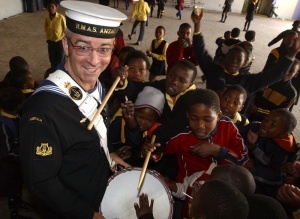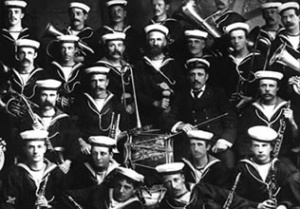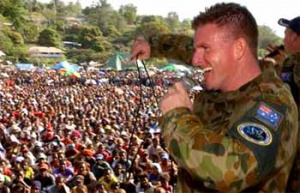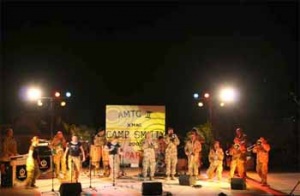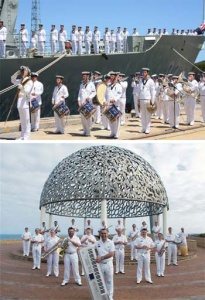RAN Band Past to Present
By Lieutenant Commander Phillip Anderson, OAM RAN
Music is the universal language of mankind [1]
- Henry Wadsworth Longfellow
The Royal Australian Navy Band plays an invaluable role in keeping Navy’s image in the public consciousness, and it maintains one of Navy’s most consistent and significant public engagement profiles. Its musicians promote awareness in the wider community of Navy’s critical contribution to the nation and reflect the quality of Navy’s people and the values for which we all aspire.[2]
The band comprises two full-time detachments and four part-time detachments positioned across Australia, and is one of the few platforms in which Navy can deliver its message to the people of Australia. Its musicians also add significant value to deployments undertaken by major fleet units. Through ship borne deployments of small elements of musicians, the band provides personnel who are cross trained in a range of mariner and non-category specific skills. This enables its musicians to make a very meaningful contribution to the capability of the ships that they join as well as adding value to the Fleet's engagement profile ashore.
Navy’s musicians have demonstrated a strong and proud record of service. Prior to and immediately after Federation, music was provided in the various state Navies by bands formed within the structure of each group. While records are scarce, there are indications that in 1879 the Fremantle Naval Volunteers (sometimes referred to as the Fremantle Naval Brigade or Naval Artillery Volunteers) formed a fife and drum band. In 1893, the New South Wales Naval Brigade Band comprised 22 personnel. Another of the very early naval bands was the Band of the Victorian Naval Brigade. This band, which comprised personnel from the permanent service and Naval Brigade, deployed to China as part of the naval contingent that assisted in quelling the Boxer uprising,[3] and was present (as a band of the Commonwealth Naval Force in 1901) at the arrival of the US Navy's ‘Great White Fleet’ into Port Phillip Bay in 1908.
Some months prior to the commissioning of HMAS Australia (I) at Portsmouth on 21 June 1913, six musicians (recruited in Melbourne) were sent to England to join up with a number of ex-Royal Marine and British Army bandsmen. These musicians, who formed the first band established under the title ‘Royal Australian Navy’, were kitted up in the Royal Marine uniform[4] of the period and arrived in Sydney in HMAS Australia (I) on 4 October 1913.
A second band was formed in 1927 for Flinders Naval Depot, now HMAS Cerberus. This band consisted of permanent musicians assisted by volunteers from all branches within the depot. By the late 1930s, in addition to bands in shore establishments, there was a rapid expansion in musician recruitment with a total of five bands at sea, serving in the cruisers Australia (I), Canberra (I), Hobart (I), Perth (I) and Sydney (II).
During WWII, musicians served with distinction in HMA Ships in all theatres of war. To supplement their musical duties, they worked as gun crews, shell bearers in magazines, in transmitting stations, as first aid parties and as lookouts through day and night watches. Fatalities occurred, and given the fact that cruisers were prime enemy targets, musicians were among those unfortunate sailors who lost their lives in HMA Ships Perth (I), Australia (I), Penguin (I), Canberra (I) and Sydney (II). Musicians also saw action aboard the carrier HMAS Sydney (III) in Korean waters in 1953, and a total of 172 musicians served aboard HMA Ships Sydney and Melbourne (II) during the Vietnam conflict. These two bands also performed separate concert tours of South Vietnam in 1970. By 1973, the only band remaining afloat was serving aboard HMAS Melbourne, and this band transferred to HMAS Stalwart (II) on the decommissioning of the ageing carrier in mid-1982.
Without a carrier, the ability of the band's musicians to serve at sea was very limited for a short while after 1982. Although the Navy's larger ships possessed some spare capacity when not conducting operations, the majority of the Fleet consisted of ships of frigate size and smaller, with little excess accommodation above the requirements of their crews. Nonetheless, after a brief absence, the band successfully renewed and reconfigured itself to take account of the changed environment, and re-established links with the Fleet through regularly embarking small musical ensembles for major deployments. Then as now, the musicians assisted in establishing strong morale within the ship in which they were embarked, as well as making a valuable contribution to the promotion of Navy’s interests ashore with public performances.
Honours and Awards
Member of the Military Division of the Most Excellent Order of the British Empire (MBE)
- Commissioned Bandmaster Joshua Ventry, RAN - 1 January 1935
- Lieutenant Commander George Hooker, RAN - 13 June 1957
Member of the Order of Australia (AM)
- Lieutenant Commander William Warland Farrell, RAN - 11 June 1984
In recognition of service to the Musician Branch of the RAN. - Lieutenant Commander Ashley William Greedy, RAN - 26 January 1993
In recognition of service to the RAN, particularly as Musical Director of the Victoria Naval Band.
Medal of the Order of Australia (OAM)
- Lieutenant Commander Phillip Charles Anderson, RAN - 14 June 2004
For meritorious service to the Royal Australian Navy and the Navy Band in the field of music. - Warrant Officer Geoffry Alan Russell, RAN - 13 June 1983
For service in the training of musicians in the Royal Australian Navy School of Music. - Chief Petty Officer Leslie Harold Lyndon Wright, RAN - 9 June 1986
For service to the Fremantle Port Division of the Royal Australian Naval Reserves while serving at HMAS Leeuwin. - Chief Petty Officer Rodney Thomas Coughran-Lane, RAN - 26 January 1995
In recognition of service to the RAN, particularly in the field of Ceremonial Music as Drum Major RAN Band, Vic.
Conspicuous Service Medal (CSM)
- Able Seaman Musician Kirstin Hansch - 8 June 2015
For meritorious devotion to duty as Assistant Staff Officer Honours and Awards, Fleet Headquarters. - Chief Petty Officer Musician Martyn Hancock - 14 June 2014
For meritorious achievement as a Leading Seaman in the Royal Australian Navy Band in the area of composing and music arrangement.
Australia Day Medallion
- Chief Petty Officer Musician Martyn Hancock - 2011
In appreciation of the acclaimed music compositions and arrangement prepared for the Royal Australian Navy Band.
Representation and Deployments
| Year | Operation/Deployment Name | Details |
| 2002 | Operation RELEX II (Christmas Island) | 5 musicians deployed in HMAS Kanimbla (II) |
| North East Asia deployment | 8 musicians deployed in HMAS Sydney (IV) | |
| 2003 | Operation SLIPPER/FALCONER (Arabian Gulf) | 4 musicians deployed in HMAS Kanimbla (II) |
| South East Asia deployment | 8 musicians deployed in HMAS Adelaide (II) | |
| South West Pacific deployment | 8 musicians deployed in HMAS Warramunga (II) | |
| North East Asia deployment | 7 musicians deployed in HMA Ships Tobruk (II) and Arunta (II) | |
| 2003/2004 | Operation CATALYST (Middle East Area of Operations - MEAO) | 17 musicians deployed in support of Forces Advisory Committee on Entertainment (FACE) Tour de Force |
| 2004 | Anzac Day (Anzac Cove, Turkey) | 15 musicians |
| Anzac Day (Camp Victory, Baghdad, Iraq) | 1 bugler | |
| Exercise Rim of the Pacifc (RIMPAC) | 4 musicians deployed in HMAS Parramatta (IV) | |
| North East Asia deployment | 8 musicians deployed in HMAS Anzac (III) | |
| South West Pacific deployment | 8 musicians deployed in HMAS Tobruk (II) | |
| 2005 | Operation NORTHERN TRIDENT | 8 musicians deployed in HMAS Anzac (III) |
| Operation ANODE | 16 musicians deployed in support of FACE Tour de Force | |
| Visit to Broome, WA | 10 musicians deployed in HMAS Kanimbla (II) | |
| South West Pacific deployment | 8 musicians deployed in HMAS Stuart (III) | |
| 2005/2006 | Operation CATALYST (MEAO) | 19 musicians deployed in support of FACE Tour de Force |
| 2006 | South East Asia deployment | 11 musicians deployed in HMAS Tobruk (II) |
| Exercise RIMPAC | 11 musicians deployed in HMAS Manoora (II) | |
| Operation CATALYST (MEAO) | 3 musician technicians deployed in support of FACE Tour de Force | |
| Chief of Defence Force - Operation TROMBONE | 66 musicians deployed for Brunei International Military Tattoo, representing ADF | |
| South East Asian deployment | 11 musicians deployed in HMAS Tobruk (II) | |
| 2007 | Operation ANODE | 16 musicians deployed in support of Tour de Force |
| Gallipoli ANZAC Pilgrimage | 15 musicians | |
| Indian South Asia deployment | 6 musicians deployed in HMAS Adelaide (II) | |
| North East Asia deployment | 10 musicians deployed in HMAS Parramatta (IV) | |
| North America deployment | 10 musicians deployed in HMAS Sydney (IV) | |
| 2008 | Operation CATALYST | 12 musicians deployed in support of Tour de Force |
| Exercise RIMPAC | 11 musicians deployed in HMAS Tobruk (II) | |
| Coronation of King Tupou V (Tonga) | 34 musicians | |
| 2009 | Operation NORTHERN TRIDENT | 12 musicians deployed in HMAS Anzac (III) |
| Exercise BERSAMA LIMA (South East Asia) | 6 musicians deployed in HMAS Darwin | |
| 2010 | Gallipoli ANZAC Pilgrimage | 17 musicians |
| Exercise RIMPAC | 12 musicians deployed in HMAS Kanimbla (II) | |
| Operation SLIPPER | Four musicians deployed in support of FACE | |
| 2011 | Operation RESOLUTE | 2 musicians deployed respectively as part of Transit Security Element |
| International Defence Exhibition & Conference (IDEX), UAE | 33 musicians | |
| Brunei Military Tattoo | 50 personnel | |
| China Military Tattoo (Nanchang) | 51 musicians | |
| 2012 | Operation SLIPPER | 4 musicians deployed in support of FACE |
| 70th Anniversary of the Battle of the Coral Sea and Anzac Day (Washington, USA) | 5 musicians | |
| Operation ASTUTE | 4 musicians deployed in support of FACE | |
| 50th Anniversary of Independence celebrations (Samoa) | 7 musicians | |
| War of 1812 Bicentennial Celebrations (Baltimore, Maryland, USA) | 15 musicians | |
| Hong Kong Military Tattoo | 31 musicians | |
| Royal Edinburgh Military Tattoo | 19 musicians deployed as part of ADF Tri-Service Band | |
| Operation ANODE | 5 musicians deployed in support of FACE | |
| 2013 | Exercise BERSAMA LIMA (South East Asia) | 5 musicians deployed in HMAS Parramatta (IV) |
| Gallipoli ANZAC Pilgrimage | 17 musicians | |
| Operation ANODE | 4 musicians deployed in support of FACE | |
| Operation SLIPPER | 5 musicians deployed in support of FACE | |
| Operation SLIPPER (MEAO) | 5 musicians deployed in support of Forces Entertainment Tour | |
| Exercise BERSAMA LIMA | 6 musicians deployed in HMAS Parramatta (IV) | |
| 2014 | PLA-Navy International Fleet Review (Qingdao, China) | 20 musicians deployed in support of 65th anniversary of the People’s Liberation Army (PLA) Navy |
| Centenary of ANZAC Commemorations (Rabaul, PNG) | 8 musicians | |
| Sydney/Emden Centenary Commemoration (Cocos Islands) | 15 musicians | |
| Operation MAZURKA | 3 musicians deployed in support of Forces Entertainment Tour | |
| 2015 | Anzac Day Commemorations (France) | 20 musicians deployed to represent ADF |
| Anzac Day Commemorations (Belgium) | 1 musician (bugler) deployed to represent ADF | |
| Operation RESOLUTE | 2 musicians deployed respectively as part of Transit Security Element | |
| Operation NORTHERN TRIDENT | 5 musicians deployed in HMAS Anzac (III) and in support of centenary of ANZAC commemorations in Turkey | |
| Operation HIGHROAD - Middle East Region (MER) | 4 musicians deployed in support of Forces Entertainment Tour | |
| 2016 | India International Fleet Review | 30 musicians deployed to represent Navy |
| Gallipoli ANZAC Pilgrimage | 17 musicians deployed to represent ADF | |
| Operation HIGHROAD (MER) | 4 musicians deployed in support of Forces Entertainment Tour | |
| Exercise RIMPAC | 12 musicians deployed in HMAS Canberra (III) | |
| 19 SQN Support (Malaysia) | 12 musicians deployed to support RAAF Butterworth | |
| 2017 | Anzac Day Commemorations (Belgium) | 1 musician (bugler) deployed to represent ADF |
| Operation ACCORDION/OKRA (MER) | 4 musicians deployed in support of Forces Entertainment Tour | |
| Indo-Pacific Endeavour | 12 musicians deployed in HMAS Adelaide (III) | |
| Nanchang International Tattoo | 29 musicians deployed to represent Navy | |
| 2018 | Gallipoli ANZAC Pilgrimage | 17 musicians deployed to represent ADF |
| Anzac Day Commemorations (Belgium) | 1 musician (vocalist) deployed to represent ADF | |
| Invictus Games (Sydney) | 30 musicians engaged to represent ADF | |
| Pacific Partnership Exchange Program | 2 musicians on exchange with United States Navy Band | |
| Indo-Pacific Endeavour and RIMPAC | 12 musicians deployed in HMAS Adelaide (III) | |
| 2019 | Anzac Day Commemorations (France) | 19 musicians deployed to represent ADF |
| Pacific Partnership Exchange Program | 2 musicians on exchange with United States Navy Band | |
| Indo-Pacific Endeavour | 8 musicians deployed in HMAS Choules | |
| Operation ACCORDION/OKRA (MER) | 4 musicians deployed in support of Forces Entertainment Tour |
During these deployments, Navy’s musical seafarers have been employed in a variety of roles including for general duties in cafe and laundry parties and in the galley, on watch in the bridge, on the helm, and as members of the ship’s force protection teams. For Operation SLIPPER and Operation FALCONER the musicians worked as members of a Flight Deck Team in HMAS Kanimbla.
The Commanding Officer HMAS Arunta reported that his detachment of musicians “significantly contributed to the Task Group achieving its goals of representing Australia to the nations of South East Asia”.[5] He added further that “in a Navy of pressing operational imperatives the detachment has proved a powerful weapon in winning the hearts and minds of the people in which they have been in contact”.[6] His report is reflective of many other reports attesting to the value of embarking a detachment of musicians. During HMAS Anzac’s visit to South Africa, one of the band’s musicians sang at the rugby union match in Johannesburg between the Wallabies and the Springboks on 23 July this year. The performance was broadcast around the world and significantly raised Anzac’s profile during her visit to South Africa.
The deployment of 17 musicians to the Middle East Area of Operations during Christmas 2003 and the New Year 2004, as part of the musical Tour de Force sponsored by the Forces Advisory Council on Entertainment (FACE), demonstrated to Australian and Coalition forces the calibre of Navy’s musicians as well as the band's impressive musical capability. During Anzac Day 2004 the band had 15 musicians at Cove and one of its buglers also performed at the Dawn Service in Baghdad.
The band’s role in supporting Australia's Regional Assistance Mission to the Solomon Islands, and its redeployment to the Middle East Area of Operations (MEAO) further enhanced the band's reputation. The deployment to the Solomon Islands in July, sponsored by the Forces Advisory Council for Entertainment (FACE), was a resounding success. The highlight of the deployment was a concert in Honiara in front of more than 20,000 people. The band contingent comprised musicians from the Melbourne and Sydney detachments and presented a high energy program performed entirely from memory.
The success of the redeployment to the MEAO during Christmas 2005 and the New Year 2006, also sponsored by FACE, should not be understated. The 19 strong contingent comprising members from the Melbourne and Sydney detachments, Defence Force School of Music and the Directorate of Music, completed 25 performances over a 16 day period in eight separate locations moving more than three and a half tonnes of equipment. This was in addition to the four days of in theatre military training. There were twelve major concerts (where civilian artists joined the band) with performance times ranging from one and a half hours to three hours. The entire program was performed from memory with a high level of choreography. An additional three and a half hours were required for the set up and pack down. Once again, Navy’s musicians made a truly magnificent contribution to Australian and Coalition Forces during the important holiday season. The band returned to the Solomon Island in 2007 for a second tour and to the MEAO in 2008 for its third tour; this time travelling within Afghanistan as well as throughout Iraq.
The deployment of 66 musicians to Brunei in July 2006, as part of the contribution by the Australian Defence Force to the celebrations marking the Sultan's 60th birthday showcased the band’s ceremonial capabilities: the band stood alone in the quality and uniqueness of its presentation, which was warmly received and highly regarded.
Of its 106 full time personnel the band has 27 members entitled to wear the Australian Active Service Medal, 11 of whom are also entitled to wear the Iraq campaign medal. Importantly, a high percentage of its people have served at sea and the band continues to provide a very impressive output for Navy at home and abroad.
In Australia each year, the band completes more than 500 missions with audience numbers in the hundreds of thousands.[7] Importantly, the band is able to keep Navy's image alive in communities far removed from any naval presence. Tasks range from supporting local community groups and ex-service associations to supporting ceremonial, public relations and social activities for the wider naval family.
The presence of the band at Welcome Home and Departure Ceremonies for ships deploying to and returning from Operation CATALYST adds “immeasurably to the importance of those occasions for our people and their loved ones”.[8] It is interesting to note that in 1900, on the eve of Federation, the bluejacket New South Wales Naval Brigade Band farewelled Australia’s Naval Expedition to the Boxer uprising. The expedition comprised members of the New South Wales, Victorian and South Australian colonial naval forces, and sailed from Cowper Wharf at Woolloomooloo.[9] Today’s Navy Band continues the tradition established by the bluejacket band, however, instead of playing ‘Sons of the Sea’, as was the case in 1900,[10] today’s musicians perform the popular tune ‘I Am Australian’ and Australia’s national song, ‘Waltzing Matilda’.
The Royal Australian Navy Band has performed on the shores of Gallipoli and in the bunkers of Vietnam, throughout Iraq and the Middle East, at the Royal Tournament and in Disneyland, at the Pope’s summer palace (Castel Gandolfo), and in the ‘Big Egg’ Stadium in Japan. It supports Navy’s regional engagement profile overseas and maintains a strong commitment schedule across Australia. These performances throughout Australia and the four corners of the world have created the proud traditions upheld by Navy’s current generation of musicians.
References
- ↑ Stevenson’s Book of Quotations, Cassell, London, 1964, p. 1362.
- ↑ RW Gates (MCAUST) in a signal to the RAN Band, 1 July 2003
- ↑ B Nicholls, Blue Jackets and Boxers, Allen & Unwin, Sydney, 1986, p. 45.
- ↑ The band changed from the Royal Marine uniform to the sailors uniform in 1960.
- ↑ Commanding Officer, HMAS Arunta, message dated 4 November 2003, para. 1.
- ↑ Ibid., para. 4.
- ↑ Royal Australian Navy Band Annual Report 2004/2005, July 2005, pp. 4-6.
- ↑ RW Gates, loc.cit., para. 3.
- ↑ B Nicholls, loc.cit., p. xi.
- ↑ Ibid.

